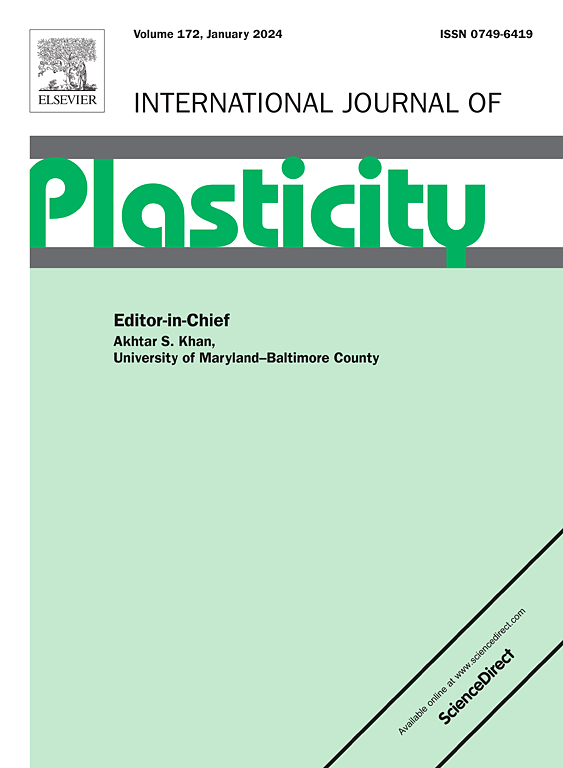A meso-scale model to predict flow stress and microstructure during hot deformation of IN718WP
IF 9.4
1区 材料科学
Q1 ENGINEERING, MECHANICAL
引用次数: 0
Abstract
This research presents a dislocation-based hot deformation model to address a nickel-based superalloy's flow stress response and discontinuous dynamic recrystallization (DDRX) behavior. The developed model can predict the flow curves and subsequent microstructure evolutions during the hot deformation. The evolution of microstructure-reliant internal variables was predicted and validated thoroughly. Furthermore, the influence of strain rate and temperature on the glide and climb velocities have also been discussed to reveal more insights into the microstructural development. Dislocation density and DDRX fraction predicted from the model was compared with dislocation density and DDRX fraction obtained from electron backscattered diffraction (EBSD) measurements with reasonable matching. Higher temperatures and slower strain rates provide favorable conditions for DDRX in this alloy. The importance of this model relies on its prediction capability in terms of flow curve, mobile and immobile dislocation densities, DDRX fraction, grain size and dislocation velocities. Single set of parameters were obtained from twelve experimental curves and rest of the eleven curves were predicted by the model using those parameters. The present research approach is helpful to predict the multiple flow curves along with the corresponding microstructure evolution in LSFE materials.
用细观尺度模型预测IN718WP热变形过程中的流变应力和微观组织
本文提出了一种基于位错的热变形模型来研究镍基高温合金的流变应力响应和不连续动态再结晶(DDRX)行为。所建立的模型可以预测热变形过程中的流动曲线和随后的组织演变。对微观结构相关内变量的演化进行了预测和验证。此外,还讨论了应变速率和温度对滑动和爬升速度的影响,以揭示微观组织发展的更多信息。将模型预测的位错密度和DDRX分数与电子背散射衍射(EBSD)测量得到的位错密度和DDRX分数进行了比较,得到了合理的匹配。较高的温度和较低的应变速率为该合金中的DDRX提供了有利的条件。该模型的重要性在于其在流动曲线、可动和不可动位错密度、DDRX分数、晶粒尺寸和位错速度等方面的预测能力。从12条实验曲线中得到一组参数,其余11条曲线用该参数进行模型预测。本文的研究方法有助于预测LSFE材料的多重流动曲线及其相应的微观结构演变。
本文章由计算机程序翻译,如有差异,请以英文原文为准。
求助全文
约1分钟内获得全文
求助全文
来源期刊

International Journal of Plasticity
工程技术-材料科学:综合
CiteScore
15.30
自引率
26.50%
发文量
256
审稿时长
46 days
期刊介绍:
International Journal of Plasticity aims to present original research encompassing all facets of plastic deformation, damage, and fracture behavior in both isotropic and anisotropic solids. This includes exploring the thermodynamics of plasticity and fracture, continuum theory, and macroscopic as well as microscopic phenomena.
Topics of interest span the plastic behavior of single crystals and polycrystalline metals, ceramics, rocks, soils, composites, nanocrystalline and microelectronics materials, shape memory alloys, ferroelectric ceramics, thin films, and polymers. Additionally, the journal covers plasticity aspects of failure and fracture mechanics. Contributions involving significant experimental, numerical, or theoretical advancements that enhance the understanding of the plastic behavior of solids are particularly valued. Papers addressing the modeling of finite nonlinear elastic deformation, bearing similarities to the modeling of plastic deformation, are also welcomed.
 求助内容:
求助内容: 应助结果提醒方式:
应助结果提醒方式:


